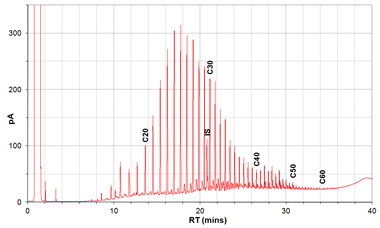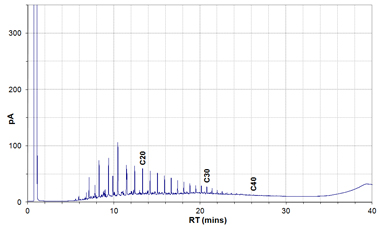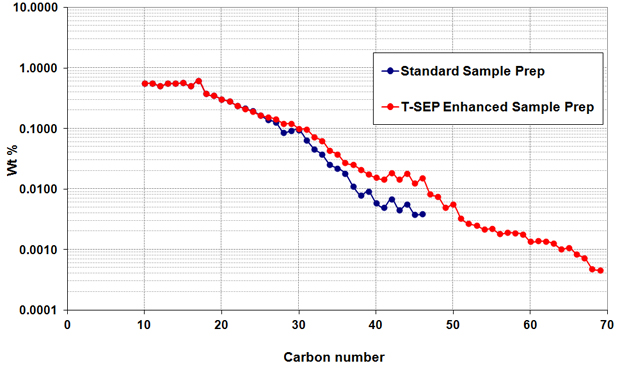T-SEP®
Compared to the relatively high concentrations of nC10 - 20 in crude oils and gas condensates [analysed as unadulterated “Whole” sample] the concentrations of >nC30 can be relatively low and either close to or below the limit of detection / quantification of the HTGC system. This is especially true for >nC50 and means that the values reported for these heavier n-alkanes may not have the same degree of accuracy as lower molecular weight n-alkanes, or cannot be accurately determined at all.
Sample “Topping”
To mitigate this problem the <nC15 fraction is typically removed through an evaporation “Topping” procedure which, in effect, concentrates the >nC20 fraction so that, even at the high end, peak areas can be more accurately determined.
Results for “Whole” and “Topped” samples are then merged by normalising the results from the “Topped” fraction based on the area of a peak present in sufficient quantities in the “Whole” sample for an accurate reading to be obtained (i.e., above the limit of detection).
T-SEP®
T-SEP® is a proprietary, small scale, thermal separation technique that has been developed by KAT in partnership with the University of Plymouth, primarily as a novel “Topping” method for crude oil and condensate samples although it is also applicable to several other processes.


This technology enables precise control over the “Topping” process and is more reproducible and effective than the simple evaporation techniques employed by most laboratories, allowing on average an additional 20 carbon numbers to be observed and accurately measured.
n-Paraffin Weight Distributions with and without T-SEP® Enhanced Sample Preparation


In addition to extending the analysis of the parent hydrocarbon fluids, T-SEP® is regularly used to enhance the analysis of associated deposits and has been used in the semi-quantitative fingerprinting of semi-solid tar-balls.

Fluid Analysis
KAT offers a suite of analyses to characterise crude oil and gas condensate samples and help assess the potential impact on production operations.SARA [latroscan]Separates the test fluid into four solubility classes: Saturate (Paraffin), Aromatic, Resin, and Asphaltenes using the Iatroscan…
Asphaltenes
Asphaltenes are a natural constituent of many crude oils and may be precipitated in production systems when the crude’s natural solvency for them is reduced. Several factors including, pressure, temperature, and composition can change the stability of these high molecular…
Separation
Foaming When produced and transported from the reservoir to processing facilities, fluids experience a drop in pressure. This will release dissolved gases that can cause the fluids to foam. Evolved gas is removed in a separator, but foaming can lead…
Gas Hydrates
Gas hydrates are crystalline solids with cage-like structures [clathrates] in which a hydrocarbon molecule is enclosed in a lattice of water molecules. Although they have the appearance of ice or snow, gas hydrates crucially form at pressures and temperatures above…
Oilfield Scale
Oilfield scale is the term used to describe deposits of insoluble inorganic minerals such as calcium carbonate, barium sulphate, and metal sulphides. In general, scale deposits occur when waters with different ion contents are mixed although pressure and pH can…
Rheology
Dynamic Viscosity Dynamic Viscosity vs. Temperature curves for assessing the flow behaviour of a waxy [Non-Newtonian] fluid are produced at a range of shear rates corresponding to typical production flowrates during normal steady-state pipeline flowing conditions. As such, each curve…
Wax Appearance
Waxes are generally defined as paraffinic material with carbon numbers greater than nC17. Waxes are present in oil as a distribution of molecular weights and thus exhibit a range of solubilities, precipitating over a range of conditions. Precipitation is temperature…
Wax Deposition
The build-up of solid waxy layers onto cooled surfaces such as pipe walls is generally considered to be a temperature-dominated phenomenon. Several theories have been proposed to describe the effect and several commercial semi-empirical models have been developed to predict…
Arn Acids
Napthenate Solids Naphthenate solids are naturally occurring oilfield fluid scales formed from reactions between a specific group of high molecular weight cyclic naphthenic ARN acids, also known as Tetra Protic Acids or Tetra-Acids, with dissolved divalent cations [such as Ca,…
T-SEP®
Compared to the relatively high concentrations of nC10 – 20 in crude oils and gas condensates [analysed as unadulterated “Whole” sample] the concentrations of >nC30 can be relatively low and either close to or below the limit of detection /…